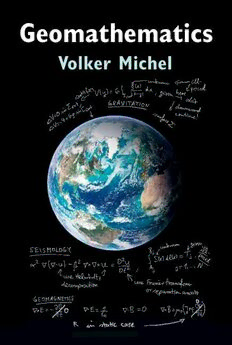
Geomathematics: Modelling and Solving Mathematical Problems in Geodesy and Geophysics PDF
Preview Geomathematics: Modelling and Solving Mathematical Problems in Geodesy and Geophysics
GEOMATHEMATICS Geomathematics provides a comprehensive summary of the mathematical prin- ciples behind key topics in geophysics and geodesy, covering the foundations of gravimetry,geomagnetics,andseismology.Theoremsandtheirproofsexplainwhy physicalrealitiesingeosciencearethelogicalmathematicalconsequencesofbasic laws.Thebookalsoderivesandanalyzesthetheoryandnumericalaspectsofestab- lishedsystemsofbasisfunctionsandpresentsanalgorithmforcombiningdifferent types of trial functions. Topics cover inverse problems and their regularization, the Laplace/Poisson equation, boundary-value problems, foundations of potential theory, the Poisson integral formula, spherical harmonics, Legendre polynomials andfunctions,radialbasisfunctions,theBiot–Savartlaw,decompositiontheorems (orthogonal, Helmholtz, and Mie), basics of continuum mechanics, conservation laws,modellingofseismicwaves,theCauchy–Navierequation,seismicrays,and travel-time tomography. Each chapter ends with review questions, with solutions forinstructorsavailableonline,providingavaluablereferenceforgraduatestudents andresearchers. volker michel isamathematicsprofessorattheUniversityofSiegen,wherehe foundedthegeomathematicsgroup.Heisalsoaneditor-in-chiefoftheInternational Journal on Geomathematics and a member of the editorial boards of the Journal of Geodesy and Mathematics of Computation and Data Science. Previous works include Lectures on Constructive Approximation (2013) and Multiscale Potential Theory (2004) with Willi Freeden. Michel has organized several conferences on inverseproblemsandgeomathematics. GEOMATHEMATICS Modelling and Solving Mathematical Problems in Geodesy and Geophysics VOLKER MICHEL UniversityofSiegen UniversityPrintingHouse,CambridgeCB28BS,UnitedKingdom OneLibertyPlaza,20thFloor,NewYork,NY10006,USA 477WilliamstownRoad,PortMelbourne,VIC3207,Australia 314–321,3rdFloor,Plot3,SplendorForum,JasolaDistrictCentre, NewDelhi–110025,India 103PenangRoad,#05–06/07,VisioncrestCommercial,Singapore238467 CambridgeUniversityPressispartoftheUniversityofCambridge. ItfurtherstheUniversity’smissionbydisseminatingknowledgeinthepursuitof education,learning,andresearchatthehighestinternationallevelsofexcellence. www.cambridge.org Informationonthistitle:www.cambridge.org/9781108419444 DOI:10.1017/9781108297882 ©CambridgeUniversityPress2022 Thispublicationisincopyright.Subjecttostatutoryexception andtotheprovisionsofrelevantcollectivelicensingagreements, noreproductionofanypartmaytakeplacewithoutthewritten permissionofCambridgeUniversityPress. Firstpublished2022 PrintedintheUnitedKingdombyTJBooksLimited,PadstowCornwall AcataloguerecordforthispublicationisavailablefromtheBritishLibrary. ISBN978-1-108-41944-4Hardback Additionalresourcesforthispublicationatwww.cambridge.org/9781108419444. CambridgeUniversityPresshasnoresponsibilityforthepersistenceoraccuracyof URLsforexternalorthird-partyinternetwebsitesreferredtointhispublication anddoesnotguaranteethatanycontentonsuchwebsitesis,orwillremain, accurateorappropriate. Tomyparents RitaMichel(1938–2015) andWalterMichel(1937–2019) Contents 1 Introduction page1 2 RequiredMathematicalBasics 4 2.1 SomeImportantDefinitions 4 2.2 AShortCourseonTensors 7 2.3 Derivatives:NotationsandMore 11 2.4 SomeTheoremsonIntegration 13 2.5 SelectedTopicsofFunctionalAnalysis 17 2.6 CurvesandSurfaces 45 3 OnGravitation,HarmonicFunctions,andRelatedTopics 50 3.1 TheGravitationalPotential 50 3.2 SomeFundamentalPropertiesofHarmonicFunctions 70 3.3 Boundary-ValueProblems,Green’sFunction,andLayerPotentials 79 3.4 TheSphereasaParticularBoundary 115 3.5 ABriefExcursiontoOtherDimensions 137 Exercises 139 4 BasisFunctions 142 4.1 SphericalAnalysis 142 4.2 SphericalHarmonicsandLegendrePolynomials 151 4.3 VectorSphericalHarmonics 168 4.4 TensorSphericalHarmonics 183 4.5 OntheMultitudeofTrialFunctions 191 4.6 SlepianFunctionsontheSphere 194 4.7 RadialBasisFunctionsandSobolevSpaces 211 4.8 BasisFunctionsonthe3DBall–Briefly 232 4.9 ABestBasisAlgorithm 237 Exercises 263 vii viii Contents 5 InverseProblems 264 5.1 Example1:DownwardContinuation 264 5.2 Example2:InverseGravimetry 266 5.3 BasicTheoryofInverseProblemsandTheirRegularization 271 5.4 BestBasesforIll-PosedInverseProblems 305 Exercises 322 6 TheMagneticField 325 6.1 TheGoverningEquations 325 6.2 TheGaußRepresentationandInnerandOuterSources 327 6.3 The Spherical Helmholtz Decomposition and the Mie Representation 329 6.4 InternalandExternalFieldsundertheMieRepresentation 344 Exercises 349 7 MathematicalModelsinSeismology 350 7.1 ContinuumMechanicswithFocusonElasticity 350 7.2 SpecificsandSimplificationsfortheElasticBodyEarth 374 7.3 PropagationofBodyWavesandNormalModes 386 7.4 AnInverseProbleminSeismology 406 Exercises 423 AppendixA HintsfortheExercises 425 AppendixB QuestionsforUnderstanding 428 References 433 Index 447 1 Introduction Ichbehaupteaber,dassinjederbesonderenNaturlehrenursovieleigentliche Wissenschaftangetroffenwerdenkönne,alsdarinMathematikanzutreffenist. [ButImaintainthatineveryspecialnaturaldoctrineonlysomuchscienceproper istobemetwithasmathematics.] ImmanuelKant,1786 EratosthenesofCyrene,wholivedbasicallyinthethirdcenturyBC,wasoneofthosefirst mathematicianswhoseknowledgeandabilitiesattheseearlystagesofhumancivilization wereremarkable.Besideshismethodforseekingprimenumbers,heparticularlyalsocon- tributed to the measurement of the Earth by, for example, determining its circumference. Inthisrespect,hemighthavebeenthefirstgeomathematician,oratleastoneofthefirst. Manymorefollowedhim,anddefinitelyCarlFriedrichGaußmustbementionedhere,as he can be seen as the greatest genius in mathematical history. His works and their influ- ence are widespread in mathematics, and they are also of essential importance in various applications,inparticularand(intheauthor’spossiblybiasedpointofview)firstofallin Earthsciences,especiallygeomagneticsandpotentialtheory.Theawareness,whichreaches back to classical antiquity, that mathematics is the foremostly required skill and toolbox forunderstandingtheobjectsandprocessesthatsurroundushasbeenpreserveduptothe present.Ithasnicelyandmoregenerallybeenputinanutshellbytheprecedingquotation, whichisfromKant(1786);fortheEnglishtranslation,seeKant(1883).Overthecenturies, Earthsciencesandmathematicshavebothadvanced.Whiletheachievementsatthetimeof Eratosthenesandhisfellowsarenowadayspartsofthecurriculaatschools,manymodern challengesingeosciencesareequallychallengestotwenty-firstcenturymathematics. The importance of mathematics for the understanding of the entire phenomenologies whichareassociatedtotheEarthwasrecognizedandhighlightedbytheinitiativeMathe- maticsofPlanetEarth(MPE),whichwaslaunchedbyUNESCOin2013.Sincethen,the interestingeomathematicshasgrownextensivelyandmanypublicationshaveoccurredin thewakeofMPE.Certainly,theEarthisascomplexasitisversatile.Therefore,onesingle bookcannotcoverthewholemathematicswhichmodelsprocessesoccurringintheEarth,at itssurface,andintheatmosphere.Thisnewbookthatyouarecurrentlyreadingconcentrates on specific topics: gravitation, magnetics, and seismology, though also these fields could easily fill books of the same size on their own. Moreover, this book is not only devoted to the modelling of these physical areas, but also to the mathematical foundations which 1
